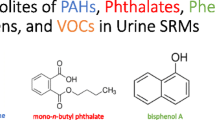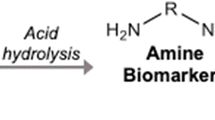Summary
Blood and urine samples were collected from 57 male Japanese solvent workers [exposed to n-hexane (Hex-A), ethyl acetate, and toluene (Tol-A) at 1.5, 2.3, and 2.3 ppm as GM-TWA, respectively] and also from 20 male nonexposed workers at the end of a 8-h shift, and analyzed for n-hexane (Hex-B) and toluene (Tol-B) in blood, and n-hexane (Hex-U), toluene (Tol-U), 2,5-hexanedione [both with (HD-U/cHYD) and without hydrolysis (HD-U/sHYD)] and hippuric acid (HA-U) in urine. Regression analysis showed that both Hex-B and Tol-B correlated significantly with corresponding exposure to the solvents. Solvents in urine (Hex-U and Tol-U) also correlated with solvents in air but with smaller correlation coefficients than the solvents in blood. Both HD-U/cHYD and HD-U/sHYD showed significant correlation with Hex-A, but HA-U failed to do so with Tol-A. Based on the correlation among biological exposure indicators and solvent concentration in air, sensitivity as an exposure indicator was compared between the solvent in blood and the metabolite in urine in terms of the lowest solvent concentration at which the exposed can be separated (with statistical significance) from the nonexposed (the lowest separation concentration; LSC). The LSC was 3.9 ppm for Hex-B, 1 to 2 ppm for HD-U/sHYD and 10 to 30 ppm for HD-U/cHYD, suggesting that HD-U/sHYD is superior even to Hex-B in detecting low n-hexane exposure; this high sensitivity of HD-U/sHYD is due to the absence of HD-U/sHYD in the urine from the nonexposed. In contrast, Tol-B (with LSC of 2.4 ppm) was more sensitive than HA-U; no LSC for HA-U could be obtained because of lack of correlation with Tol-A at low toluene exposure.
Similar content being viewed by others
References
American Conference of Government Industrial hygienists (1992) Threshold limit values and biological exposure indices. ACGIH, Cincinnati
Deutsche Forschungsgemeinschaft (1991) Maximum concentrations at the workplace and biological tolerance values for working materials 1992. VCH, Weinheim
Hirayama T, Ikeda M (1979) Applicability of carbon felt to the dosimetry of solvent vapor mixture. Am Ind Hyg Assoc J 40:1091–1096
Ikeda M, Kumai M, Aksoy M (1984) Application of carbon felt dosimetry to field studies distant from analytical laboratory. Ind Health 22:53–58
Inoue T, Takeuchi Y, Hisanaga N, Ono Y, Iwata M, Ogata M, Saito K, Sakurai H, Hara I, Matsushita T, Ikeda M (1983) A nationwide survey on organic solvent components in various solvent products: Part I. Homogeneous products such as thinners, degreasers and reagents. Ind Health 21:175–183
Jackson S (1965) Creatinine in urine as an index of urinary excretion rate. Health Phys 12:843–850
Japan Association of Industrial Health (1992) Recommended occupational exposure limits. Jpn J Ind Health 34:363–384
Kasahara M, Ikeda M (1987) Spontaneous desorption of organic solvents from carbon cloth. Ind Health 25:73–81
Kawai T, Mizunuma K, Yasugi T, Uchida Y, Ikeda M (1990) The method of choice for the determination of 2,5-hexanedione as an indicator of occupational exposure to n-hexane. Int Arch Occup Environ Health 63:69–75
Kawai T, Mizunuma K, Yasugi T, Horiguchi S, Uchida Y, Iwami O, Iguchi H, Ikeda M (1991) Urinary methylhippuric acid isomer levels after occupational exposure to xylene mixture. Int Arch Occup Environ Health 63:69–75
Kumai M, Koizumi A, Saito K, Sakurai H, Inoue T, Takeuchi Y, Hara I, Ogata M, Matsushita T, Ikeda M (1983) A nationwide survey on organic solvent components in various solvent products: Part II. Heterogeneous products such as paints, inks and adhesives. Ind Health 21:185–197
Lauwerys R (1983) Toluene. In: Alessio A, Berlin A, Roi R, Boni M (eds) Human biological monitoring of industrial chemicals series. Joint Research Centre Ispra Istablishment, Ispra, Italy, p 159–175
Mizunuma K, Kawai T, Yasugi T, Horiguchi S, Iwami O, Ikeda M (1992) In vitro hydrolysis of methyl acetate, a limitation in application of head-space gaschromatography in biological monitoring of exposure. Toxicol Lett 62:247–253
Rainsford SG, Lloyd Davies, TA (1965) Urinary excretion of phenol by men exposed to vapour of benzene: A screening test. Br J Ind Med 22:21–26
Saito J, Ikeda M (1988) Solvent constituents in paints, glue and thinner for plastic miniature hobby. Tohoku J Exp Med 155:275–283
Author information
Authors and Affiliations
Rights and permissions
About this article
Cite this article
Kawai, T., Yasugi, T., Mizunuma, K. et al. Comparative evaluation of blood and urine analysis as a tool for biological monitoring of n-hexane and toluene. Int. Arch Occup Environ Heath 65 (Suppl 1), S123–S126 (1993). https://doi.org/10.1007/BF00381322
Issue Date:
DOI: https://doi.org/10.1007/BF00381322




